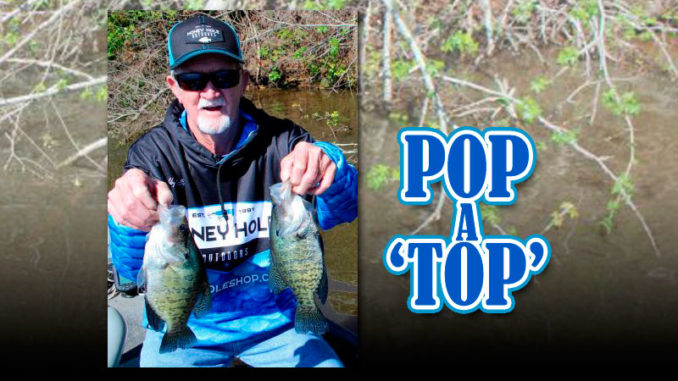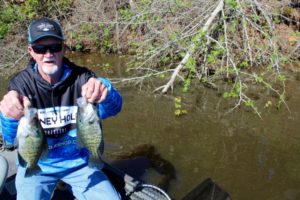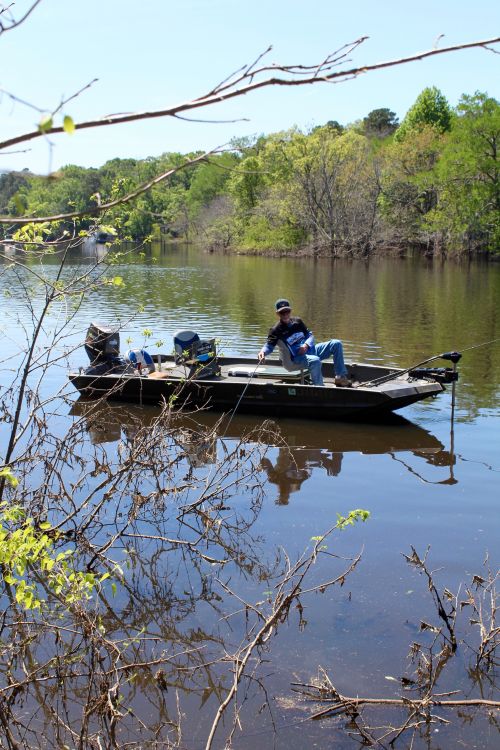
It’s prime time to target Ouachita River crappie in the tops. Here’s how one noted angler catches his share of summertime slabs hunkered down in the brush.
If you want to make Bobby Phillips smile, don’t tell him a joke. Just say, “Ouachita River crappie,” and that’s pretty much all it takes.
The amicable 74-year-old crappie fisherman will light up and say, “Where’s my pole? They’re calling my name. ”
A legend in Northeast Louisiana as a noted slab chaser and founder of the well-known Honey Hole Tackle Store in West Monroe, Phillips is always ready to hit the river in July.
“We have some fantastic crappie fishing around here, but there’s no better place to be than the Ouachita River in the summer,” Phillips said. “You can catch them in the tops single poling. You can catch them in the sloughs and river lakes spider-rigging, and you can catch them in the creeks using either technique.
“There are plenty of fish and plenty of places to fish. But here’s the deal: The river system is full of treetops, brush tops and all kinds of laydowns. They are easy to find, fairly easy to fish and provide a consistent way to catch summer crappie.”
His approach to fishing tops is simple: Be thorough, like a detective working a tough case. Fish tops from front to back, and top to bottom. And remember, don’t give up too soon.
Start out, go in
“When you find a good looking top, start on the outer edge in deeper water with a 1/32-ounce jig and swim it across the top,” Phillips said. “Work around all the edges good and see if there are any fish suspended shallow. Then fish your way in, fishing all the outer structure before moving in toward the bank. Start deep and work your way shallow. That way you don’t leave any limb unturned, and you don’t disturb any of the fish before you get to put a jig in front of their mouth.

“If you don’t have any luck, switch to a 1/16th jig and work it right down in the thickest part of the top. Go all the way to the bottom if you can and work it up slowly. If there are crappie in there, you’ll be putting the jig in front of them at some point.”
Learn as you go. And pay attention to where you are catching fish in the top, and at what depth. When you go to the next one, make sure you work that same part of the structure thoroughly. And here’s an important lesson from Phillips: Crappie don’t bite all the time. If it’s a good looking top — even if you don’t catch one — come back and try again later. They might have decided they’re actually hungry by then.
Getting hung up
Phillips fishes river tops with hair and plastic jigs this time of year. If you are out in a slough or river lake spider-rigging, shiners will catch fish. But in the tops, shiners will just keep you hung up, and you won’t be able to control where your bait needs to be.
Phillips has a good tip for keeping jig fishing from getting expensive, too.
“You lower your jig slowly and when it bumps something, gently move it to the side,” he said. “When you lift your jig to move it, gently lift it. If you move it fast, you are going to get hung. The more touch you can put on moving your jig, the fewer times you are going to get hung.”
If you do get hung, the best way to get your jig back is to point the fishing rod at the jig, reel up all the slack and push the jig off the limb with the end of your pole. Nine times out of 10, that will work unless you have wrapped your line around the limb.
“Fish generally like the jig presented in a vertical manner, straight up and down,” Phillips said. “And do your best to hold the jig still. You’ll see some guys jigging it up and down 6 inches or a foot. That isn’t the best way to fish it anywhere, and especially in a river top. Fish like the jig sitting still — and that’s also how you’ll keep it from getting hung.”
Blue Blazes

“It’s an unfortunate fact for us old men, but the river crappie seem to like to feed best in the middle of the day this time of year,” he said. “When it’s hot as blue blazes, that’s when they are going to bite, especially the good ones. That usually comes between 11 a.m. and 2 p.m. I stick with it long as I can, but when it gets too hot, I just have to go home even if they are biting.”
Phillips’ other best tips for summer tops?
Keep your eyes open when you are running up and down the river, boating through the sloughs and easing up creeks. Look for tops that have lots of limbs and cover up shallow, but also extend out into deeper water. Mark those in your mind and fish the best looking ones. As you spend more time fishing this way, remember which ones you’ve caught fish at before. Don’t be afraid to run a lot of the river looking: Sometimes you have to hit several tops before you find fish.
Current
One important tip is to try and stay in areas that don’t have much current. Crappie don’t like current, but if they are in a slight current, they typically position themselves below structure facing into it.
And while you are looking for tops to fish, also keep your eyes open in the creeks and sloughs for shad “flicking or flashing” around on the surface. They aren’t jumping for exercise, but are eating algae that has been washed up into the sloughs. When the shad are doing that, you can bet the crappie will be a foot or two under them looking for lunch, as well.
“When you see that, put out a couple of poles in a pole holder and a pole in your hand. Work through the area fishing about 18 inches deep and cover the entire area you see the shad working,” Phillips said. “It’s kind of a modified spider-rigging approach. You may feel like you are in open water, but there’s a good bet there are stickups and small sunken tops in that area as well.”
One other thing to remember: This river system is almost always on a rise or a fall. When the river is rising, go up into the creeks and back toward the banks. When the river is on a fall, Phillips said to go out with the water. Those fish love to move into new territory when the water rises, but they’ll scoot back out to the nearest deep water when it’s falling.
What’s a “top”?
A top is simply a submerged brush top, the top of a bush or tree or a fallen tree with lots of submerged limbs. Tops sometimes lay where they fall, and other times current washes them onto sandbars or into river lakes. Tops hold baitfish — and that’s where you’ll find the feeding fish. They also give fish like crappie a good place to hide from their predators.
“Tops” tips
Never underestimate a top. Fish all the way around it, and up in the middle of the thickest part. If you think fish should be there and you don’t get a bite, come back later and try again. Sometimes there may be two dozen fish in a top and they just don’t bite at certain times — but they’ll get hungry later.
Geared up and ready to go
With tackle stores full of a thousand sizes, shapes, styles and colors of crappie jigs and fishing equipment, you could spend days or weeks just trying to figure out what to fish with. Or you could just let Bobby Phillips tell you his favorite go-to gear, and copy this veteran guide’s success.
“On the river, I have two favorite hair jigs, the Black Lake Tackle 120+ (gray, red and chartreuse) and the 180 (gray and white) in two sizes, 1/32nd and 1/16th ounce,” Phillips said. “Sometimes size does make a difference, and usually the heavier jig is used in deeper water or thicker tops, especially if there is a little hint of current.”

His top choices for plastic are the Triple Threat red head, blue body and chartreuse tail jig; the Stinger Shad in popsicle pink, purple and chartreuse and Bobby Garland Baby Shad in baby crawdad and bluegrass.
He never puts a jig in the water without a white or chartreuse crappie nibble. In fact, he buys those by the case.
A lighter action rod with plenty of backbone like the Jenko Wohali with a rear seat for the reel is his favorite rod. He fishes with fly reels only, and his favorites aren’t even in production anymore. But today’s reels like the Pflueger Summit or Monarch are the closest match to his old favorites. He spools them with Izorline Platinum Hi Viz 6-pound test, tipped with a 4-pound, 18-inch Cajun Red Cast line leader.
The Ouachita’s long and winding path
There are more than 90 miles of Ouachita River between the Arkansas line and the Columbia Lock and Dam in Northeast Louisiana. The river lakes, bayous and cuts off the river are too numerous to mention. But the nice thing is that good access is available up and down the river, and prime fishing isn’t far away.

Starting on the northern end of that stretch, there is improved access and parking at Lock and Dam No. 6 at Felsenthal; Finch Bayou (Alabama Landing) near Marion; Sterlington (on the Ouachita parish side) and in Monroe/West Monroe there are three big landings: Moon Lake to the north, Forsythe Park in Monroe and Lazarre Point in West Monroe.
Prairion Bayou Recreational Area is the last major area south of Monroe before Columbia. The Columbia Lock and Dam offers access from both sides of the river at Riverton, and there is a large landing on Pearl Street in the town of Columbia.


